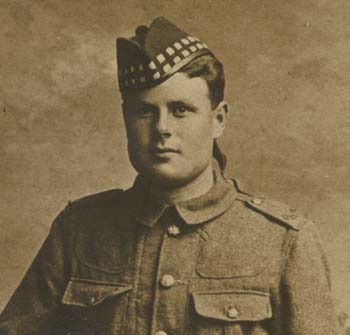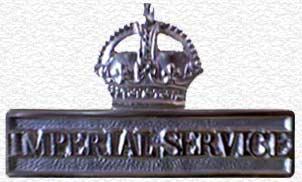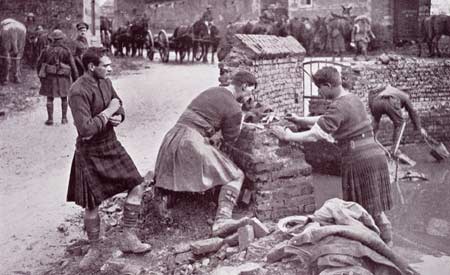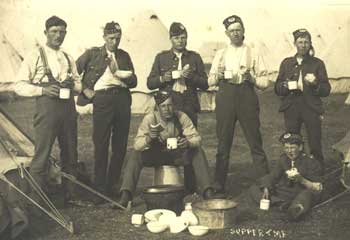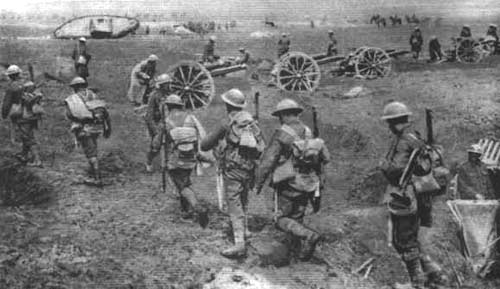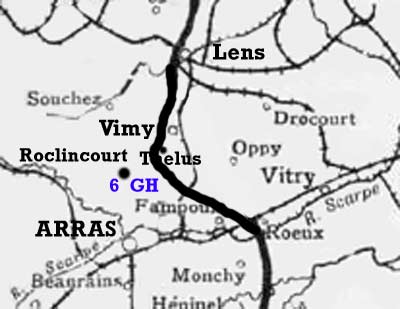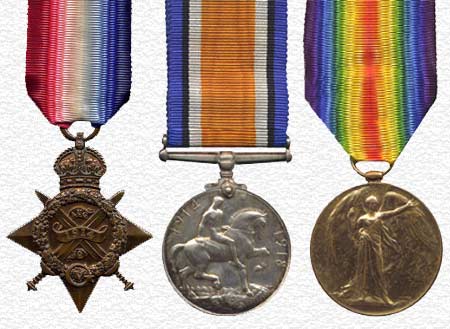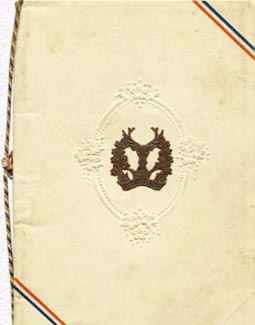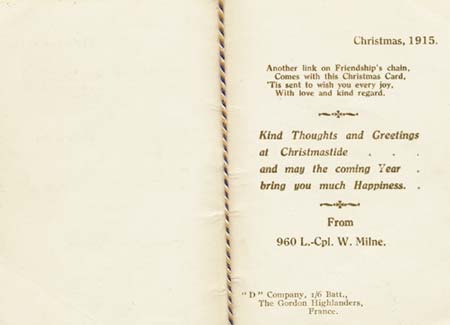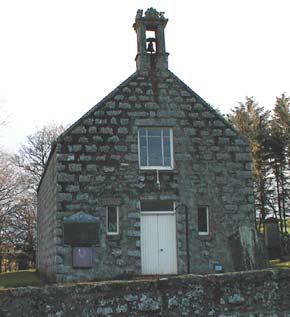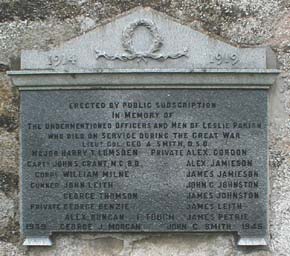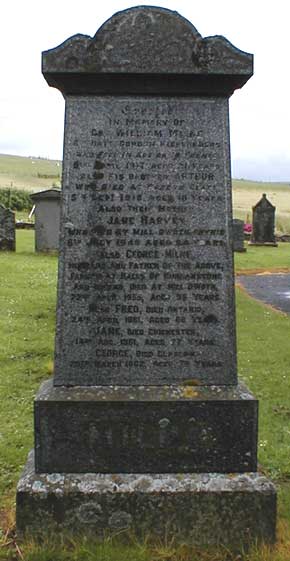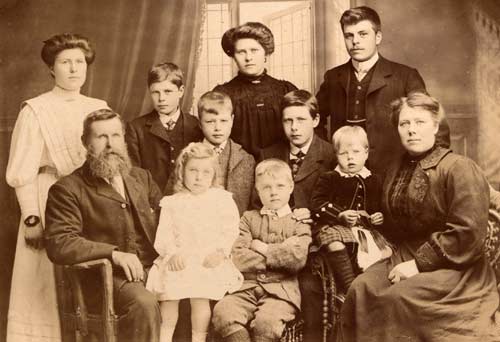|
William Milne was born on the 13th July 1895 at Timberhall near Duncanstone in the Parish of Leslie, the second son of George and and Jane Milne. At this time George was a farm servant and tenant crofter of 7 acres there, by 1901 he was in the neighbouring 50acre farm of Halls of Duncanstone and by 1914 was farming Bogend, Clatt all of which were on the Leith Hall Estate. William had five brothers and three sisters and was a farm servant on the farm of Westfield at Duncanstone, which neighboured his earlier home at Halls, when war broke out. This accounts for his name being on both Kennethmont and Leslie War Memorials. Willie married his employer George Lobban's daughter Chrissie at Westfield on August 29th 1915 while he was home on leave. They had a son, also William, who was born in 1916.
Willie and Chris Milne with William, taken late 1916 / early 1917. On joining the Territorials a soldier agreed to be available for home service only and could not be posted overseas unless he volunteered to do so, and even then could only serve in his own unit. When the threat of war came in 1914 most of the Territorial Soldiers of The Gordon Highlanders agreed to serve overseas and thus became available for 'Imperial Service'. These men, including Willie Milne and his older brother, Fred, were then entitled to wear The Imperial Service Badge.
As a member
of 'H' Company, 6th Battalion ( Donside and Banffshire), Gordon Highlanders
(Territorial Force) Willie reported to The Drill Hall in Huntly when
the Battalion were mobilised in the evening of 4th August 1914. His
company marched by road to Keith where all the companies of the 6th
Gordons assembled during 6th-7th August, the men being billeted in
the school and in private houses. Organisation completed they left
Keith by train on 11th August for Perth. On the 16th they moved on
to join The Highland Territorial Brigade in The Highland Division
at Bedford and were billeted in private houses in the Bromham Road
area of the town with their Headquarters in the Girls High School.
For three months they trained and prepared for their eventual move
to the Western Front and on 22nd October were reviewed by the King.
On 9th Nov 1914 the Battalion journeyed to Southampton by train. That
evening at the docks they joined the troopship "Cornishman".
They disembarked at Le Havre, France next morning and marched to No1
Reserve Camp on top of the hill behind the town. On the 13th
began the journey up the line ending at St Omer where the General
Headquarters of the British Army in France was located. For three
weeks they received further training for the trenches while billeted
in nearby Blendecques.
Members of 6 GH cleaning up after a tour in the trenches, the man shaving still wears the drab apron over his kilt. This was worn to camouflage the kilt and to help keep it clean and dry in the muddy trenches.
On Christmas
Day 1914 they witnessed a remarkable event amid the death and destruction
- the unofficial Christmas Truce. The truce eventually extended to
3rd January 1915, when normal hostilities resumed. In January
1915 The Huntly Express informs readers that his father, with two
sons ( Willie & Fred) serving at the front in the B.E.F.
, has received intimation from the War Office that Pte William Milne
has been admitted to a hospital in France, the cause of his illness
not yet diagnosed. It is not known when he returned to duty with his
unit. This special
Order was published by Major-General Capper -
This photograph
of 6th Gordon Highlanders in camp includes George Anderson on the
left. In May they were again in action at Festubert and Givency and at the end of September attacking in front of Hulluch at The Battle of Loos when the British used Gas for the first time. Both were fierce actions which lasted three days with very heavy loss of life. At Loos the 6th were practically cut off and had to fight their way through the enemy lines in desperate hand to hand fighting. By
December 1915 Wullie has been promoted to L Cpl and is with "D"
Company. This promotion and move were probably a result of the heavy
casualties the battalion suffered at Loos. It took many months for
the 6th to regain full strength and the four companies ( A, B, C &
D) were away from the front in Lines of Communications duties at several
Base Camps during this period. In May 1916 they joined the newly created
51st Highland Division at Vimy Ridge to the north of Arras. The 6th
Gordons were not involved in the Somme Battles which began on 1st
July 1916 but were in the line at Mametz Wood at this time. They were
in action again during the five day assault on High Wood a month later.
On 13th November they took a leading role in the assault and capture
of the village of Beaumont Hamel. Following a period out of the line near Abbeville, Wullie and his comrades started the long march back to the battle lines on February 5th 1917 and on the 17th moved into trenches at Roclincourt - a very quiet part of the front four miles north of Arras. The quiet was to last for two months with the exception of a successful daylight raid on the German line on 5th March.
British
soldiers moving forward near Arras, April
1917 Having been
promoted to Corporal during the previous fifteen months Cpl William
Milne fell in action on the first day of The Battle of Arras. He had
been on the Western Front for nearly two and a half years and was
by now " an old hand ". Fought on a twelve miles front of
The Hinderburg Line from Lens to Arras, it started on 9th April at
half-past five in the morning. The 6th Gordons in the 51st Division,
were in the Roclincourt trenches opposite Thélus and facing
the outer spurs of Vimy Ridge, in front of which, to the Division's
left, lay four Canadian divisions, while on its right was the 34th
Division. A fierce enemy barrage preluded the attack; yet Gordons,
Black Watch, Argylls, Seaforths, and Royal Scots swept through the
first objective line of the German trenches as though they had been
a triumphal arch.
The following are the entries from the 6th GH War Diary for the period. April
1917
1st - ECOIVRES. In "X" Hutments. On
the 9th the BATTLE of ARRAS opened. The objective given the Battalion
was the front line system of trenches, viz;- Firing Line, Support
Line, and Reserve Line, known as the " Black" Line.
It is unclear whether Wullie was killed during the assault or was the victim of the explosion of a Minenwerfer (Trench Mortar) ammunition dump in a deep dug-out near the enemy third line. It was never known if this was an accident or deliberate act by the Germans but the explosion formed a crater over 20 feet deep and killed or wounded 20 of the battalion as well as a number of the enemy. The 6th Battalion suffered 16 Officer and 260 Other Ranks casualties on 9th April, nearly half it's strength. The inevitable counterattacking by the enemy followed.
6GH Area of
Operations 9th April 1917.
Move mouse
over medals to view reverse William Milne
was awarded these medals for serving his King and Country in The Great
War. Having served
in the France / Flanders theatre between 5th August and 22nd November
1914 Willie qualified for the less common 1914 Star (left). It is
often referred to as The Mons Star as the majority if it's recipients
were members of The British Expeditionary Force and involved in the
retreat from Mons to the line of entrenched positions which became
The Western Front. The British
War Medal (centre) and Victory Medal (right) were awarded to all personnel.
Another link
on Friendship's chain,
Leslie Kirk and War Memorial
The Milne Family 1908 Meg, William,
Jane, George Jnr, Family photographs ( with one exception ) are reproduced
here by kind permission
of his grandnephew Keith Andreeti. |
